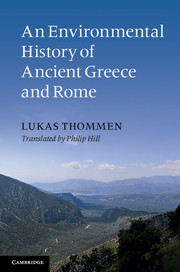Book contents
- Frontmatter
- Contents
- Figures
- Preface
- Introduction
- Part I Greece
- Chapter 1 The geographic space
- Chapter 2 People and nature
- Chapter 3 Agriculture
- Chapter 4 Forests and timber
- Chapter 5 Gardens
- Chapter 6 Animals
- Chapter 7 Food
- Chapter 8 Fire and water
- Chapter 9 Earthquakes and volcanoes
- Chapter 10 Mining
- Part II Rome
- Chronology
- Further reading
- Sources
- Bibliography
- Index
Chapter 9 - Earthquakes and volcanoes
Published online by Cambridge University Press: 05 June 2012
- Frontmatter
- Contents
- Figures
- Preface
- Introduction
- Part I Greece
- Chapter 1 The geographic space
- Chapter 2 People and nature
- Chapter 3 Agriculture
- Chapter 4 Forests and timber
- Chapter 5 Gardens
- Chapter 6 Animals
- Chapter 7 Food
- Chapter 8 Fire and water
- Chapter 9 Earthquakes and volcanoes
- Chapter 10 Mining
- Part II Rome
- Chronology
- Further reading
- Sources
- Bibliography
- Index
Summary
EARTHQUAKES
The area we are examining lies along the Mediterranean/Trans-Asian earthquake belt, and is thus exposed to a high degree of seismicity. Tectonic movements and fracture cleavages caused frequent earthquakes in antiquity. These included both subsidence earthquakes, caused by the collapse of underground caverns, and volcanic and tectonic earthquakes; mudslides and tsunamis were also classed as earthquakes. Both the actions of the gods and natural processes put forward by Ionic natural philosophy were called upon to provide explanations for these phenomena. In the mythological tradition, Poseidon, described as the ‘earth-shaker’ (Ennosigaios), was primarily held responsible for earthquakes. It was therefore necessary to avoid provoking such supernatural powers to fits of anger.
In the scientific view, three interpretations of the earthquake phenomenon arose, the ‘Neptunic’, the ‘pneumatic’ and the ‘volcanic’, along with various combinations of these. In the sixth century bc, Thales of Miletus saw the earth as a kind of ship on an ocean, the waves of which caused it to tremble (Sen. nat. 3.14.1). Anaximander and Anaximenes thought that earthquakes were triggered by air in the fissures of the earth, while Anaxagoras saw seismic shocks as the result of streams of air which had penetrated the earth (Sen. nat. 6.10.1; Amm. Marc. 17.7.12). In classical times Democritus broached the ‘Neptunic’ view that the cause of earthquakes was water currents in underground caverns which had penetrated under the flat earth's surface (Aristot. meteor. 365b), while Empedocles (D/K 31 A 68–9) and Antiphon (D/K 87 B 30–1) supported the ‘volcanic’ theory, which claimed that seismic shocks were caused by fires within the earth. Finally, a new version of the pneumatic approach, propagated by Aristotle in the fourth century bc, gained influence: it posited a porous earth filled with penetrated air (pneuma), the pressure of which increased as a result of water seeping in, so that it pressed outward (Aristot. meteor. 365a–369a). Like Antiphon (c. 480–411 bc), the scholar Posidonius (c. 135–51 bc) saw a connection between seismic and volcanic activities, and thought that fire and water were seeking a way to escape through underground passages. Posidonius also divided the earth into endangered and safe areas (cf. Strab. 12.8.17–18).
- Type
- Chapter
- Information
- An Environmental History of Ancient Greece and Rome , pp. 59 - 61Publisher: Cambridge University PressPrint publication year: 2012



